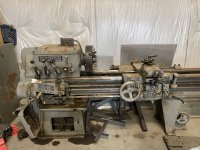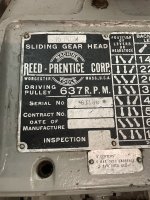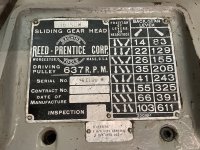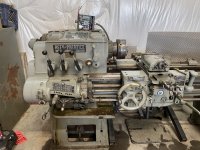I have run jobs on a few Reed & Prentice geared head engine lathes, and have owned a 16" R & P. As engine lathes go, they are up there as a heavy duty engine lathe. About the only downside to the R & P lathes was the bedways being a bit softer. An R & P lathe that saw hard use usually has some significant bed wear.
That being said, I always found the R & P lathes to be a solid, user friendly machine tool. I remember hogging a job out of a chunk of maybe 6" diameter Cr-Ni alloy steel. At the time, I was running a 16" Reed & Prentice lathe that I owned, and it had a 'lantern' style toolpost. I kept taking heavier cuts, eventually peeling off something better than 0.250" in one cut. What finally limited the depth of cut was when the force on the tool bit turned the whole toolpost. R & P used to have an advertisement showing how heavy a cut their lathes could take, with chips that looked to have come off a cut better than 1/2" deep per side.
I used ISO 46 oil in the headstock of my R & P lathe, and used a 'way lube' in the apron. My own R & P lathe dated to 1952, and had a felt filter for the lubricating oil in the headstock. The felt filter was way down deep in the back of the headstock. It is something to check and clean before putting the lathe into service again.
The broken sight glasses can be replaced using clear "Lexan" or "Plexiglass" (acrylic plastic) and some RTV silicon 'gasket eliminator' to seal them.
I believe the OP's lathe to be a bit more recent than the 1952 R & P lathe I owned. I base this on the fact that the levers on the headstock have plastic knobs on them/ The older R & P lathes had levers cast with the knobs as one piece.
Tyrone: My guess is both broken sight glasses were the handiwork of someone who either had an axe to grind with the management in the shop, or simply as an act of vandalism for self gratification. It's on the order of people chunking rocks thru any available window on abandoned buildings (or on some other buildings which become targets) and abandoned vehicles. There is a perverse mechanism in some people that makes windows and similar glass irresistable to them. Some sorry SOB smashed out the sight glasses, thinking it was great fun to watch the oil run out. I think that all of us who have lived any length of time and worked in various places have run into these sorts of people. This same sub-specie also manifests itself by drilling plenty of holes in drill press tables, with their end result making the 'arc or shame', or a drill press table that is cratered like the surface of the moon.






